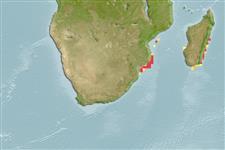Elasmobranquios (tiburones y rayas) (sharks and rays) >
Carcharhiniformes (Ground sharks) >
Scyliorhinidae (Cat sharks) > Scyliorhininae
Etymology: Cephaloscyllium: cephalus, from kephale (Gr.), head, referring to its very broad and depressed head; skylion, Greek for dogfish or small shark. (See ETYFish); sufflans: Latin for puffing, referring to its inflatable stomach. (See ETYFish).
More on author: Regan.
Environment: milieu / climate zone / depth range / distribution range
Ecología
marino demersal; rango de profundidad 40 - 600 m (Ref. 5578). Tropical; 19°S - 28°S
Distribución
Países | Áreas FAO | Ecosistemas | Ocurrencias, apariciones | Point map | Introducciones | Faunafri
Western Indian Ocean: Mozambique and Natal, South Africa (Ref. 244). Records from the Gulf of Aden are doubtful. Nominal records from Viet Nam were based on an undescribed species often called Cephaloscyllium umbratile which was not even that species.
Tamaño / Peso / Age
Maturity: Lm ? range ? - 82 cm
Max length : 110 cm TL macho / no sexado; (Ref. 5578)
Short description
Morfología | Morfometría
Espinas dorsales (total): 0; Radios blandos dorsales (total): 0; Espinas anales 0; Radios blandos anales: 0. A comparatively large, stout catshark with a broad, rounded snout and no labial furrows; 2nd dorsal much smaller than 1st (Ref. 5578). Pale grey-brown, paler below; juveniles with about 6 slightly darker saddles on the dorsal side which fade and become unmarked in adults (Ref. 5510).
Found on the continental shelf and upper slope, preferring areas with sand and mud bottoms (Ref. 5578). Feeds on benthic animals, mainly crustaceans and cephalopods, but also bony fishes, and other elasmobranches (Ref. 244). Oviparous (Ref. 50449). Can expand with air when disturbed (Ref. 244).
Life cycle and mating behavior
Madurez | Reproducción | Puesta | Huevos | Fecundidad | Larva
Oviparous, laying one egg-case per oviduct (Ref. 244). Embryos feed solely on yolk (Ref. 50449).
Compagno, L.J.V., 1984. FAO Species Catalogue. Vol. 4. Sharks of the world. An annotated and illustrated catalogue of shark species known to date. Part 2 - Carcharhiniformes. FAO Fish. Synop. 125(4/2):251-655. Rome: FAO. (Ref. 244)
IUCN Red List Status (Ref. 130435)
Threat to humans
Harmless
Human uses
Pesquerías: sin interés
Más información
Age/SizeCrecimientoLength-weightLength-lengthLength-frequenciesMorfometríaMorfologíaLarvaDinámica larvariaReclutamientoAbundanciaBRUVS
ReferenciasAcuiculturaPerfil de acuiculturaRazasGenéticaElectrophoresesheritabilidadEnfermedadesProcesamientoNutrientsMass conversion
ColaboradoresImágenesStamps, Coins Misc.SonidosCiguateraVelocidadTipo de nataciónSuperficie branquialOtolitosCerebrosVisión
Herramientas
Special reports
Download XML
Fuentes de Internet
Estimates based on models
Preferred temperature (Ref.
123201): 14.4 - 19.2, mean 15.9 °C (based on 17 cells).
Phylogenetic diversity index (Ref.
82804): PD
50 = 0.5000 [Uniqueness, from 0.5 = low to 2.0 = high].
Bayesian length-weight: a=0.00263 (0.00139 - 0.00497), b=3.21 (3.04 - 3.38), in cm total length, based on LWR estimates for this (Sub)family-body shape (Ref.
93245).
Nivel trófico (Ref.
69278): 4.2 ±0.61 se; based on food items.
Resiliencia (Ref.
120179): Bajo, población duplicada en un tiempo mínimo de 4.5-14 años (Fec assumed to be <100).
Fishing Vulnerability (Ref.
59153): High to very high vulnerability (66 of 100).
